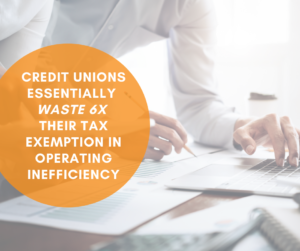


Recently I saw an article about the 50 credit unions with the highest efficiency ratio in the industry – efficiency ratio is operating expenses divided by (interest income less interest expense) plus non-interest income. This ratio is often referred to by: how much does a credit union spend to generate $1 of earnings – for example: Merck Employee’s FCU in NJ spends 34.11 cents to generate $1 in income.
There are a couple of caveats to this approach especially in the context of a member-owned financial cooperative. Remember, borrowers and depositors in credit unions by definition MUST be members of said credit union – meaning owners of the credit union. In a traditional for-profit, third-party owned entity (think bank – depositor/borrower does not equal owner and profit maximization is the mandate) efficiency ratio can be expanded by charging more for loans and in fees and paying less in interest and deposit interest.
In a credit union model, the shareholder is the depositor/borrower – thus to maximize shareholder profit, you must charge more in loan interest and pay less in deposits as well as collect more in fees from your own owners! This is a key reason I’m not a fan of efficiency ratio as the area to focus upon with respect to organizational performance.
One measure we prefer to efficiency ratio is the Operating Expense to Average Assets ratio. This measure doesn’t take into account profitability (remember, credit unions are not for profit, other than maintaining net worth levels to sustain growth, a credit union shouldn’t be hoarding profit). The measure takes into account the cost to operate the entity (buildings, people, benefits etc…) divided by assets.
All else being equal, we expect that operating assets as a percentage of assets should decrease as assets increase, this is, after all, a scale business. The difference in this measure comes to light when we study key outliers with respect to this ratio as well as banks relative to credit unions – remember, absent the profit motive, operating expense should be driven to efficiency for the benefit of the member or the benefit of the shareholders in both cases. When we look at that trend, we find that credit unions essentially cost members almost 6x their tax exemption through lower operating inefficiency. By having more employees than necessary, potentially less  productive employees, ineffective technology, and expansive real estate footprint, credit unions use more than 6 TIMES the implied value of their tax exemption!
productive employees, ineffective technology, and expansive real estate footprint, credit unions use more than 6 TIMES the implied value of their tax exemption!
As credit unions proceed through strategic planning and into 2021 and boards/compensation committees begin agreement on terms and goals for 2021 – make sure operating efficiency to average assets is near the top of the list – first get to at least where your peer credit unions are relative to your asset size, then target working toward a level commensurate to a comparable bank lies and return more to your members through increased efficiency.
